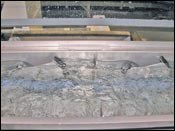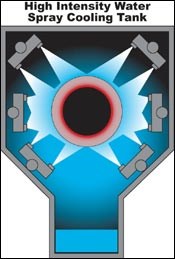Stop Profile Warpage
Processors today want to run faster, minimize scrap, and do short production runs that may only last a few hours.
Processors today want to run faster, minimize scrap, and do short production runs that may only last a few hours. However, running plastic profiles faster often causes warping, especially with complex hollow shapes having varying wall thicknesses, as well as wood/plastic composites or foamed profiles. So what do you do when your profile warps?
The simple answer is: Cool the profile more evenly. That means control heat transfer so thin sections don’t freeze off before thick sections dissipate heat. Resin and fillers also play a role. The thermal conductivity of a resin is its density times its ability to conduct heat. The thermal conductivity of PVC is 0.051, PP is 0.075, and HDPE is 0.16, where the higher number means slower heat transfer. Thus PE profiles require 20% to 30% longer tanks than PVC because of PE’s slower cooling.
VARIOUS WAYS TO COOL
How heat dissipates through a material is a matter of the materials’ thermal conductivity and thickness. As the outer skin of a profile solidifies, it insulates the inner material from the cooling medium. If a wall is thick, it becomes a more severe cooling issue.
Depending on your cooling equipment, there are different ways to fix uneven cooling. Cooling methods include air racks, water tanks, and spray-cooling tanks. Air cooling is the simplest and slowest method of heat transfer. Air has only 1% to 10% of the cooling capacity of water, so it’s less likely to cool unevenly and cause profiles to warp, twist, and bow. Typical throughput rates with air cooling are below 250 lb/hr for materials like polycarbonate, rigid PVC, and PS.
An air rack is typically 10 to 20 ft long with templates or form guides to support the profile while it cools. Clamps, bent wires, vise grips, and other devices can also help to support and guide the profile. In the first 10 ft, nozzles are typically used to blow air at specific sections of the profile, while the last 10 feet use more generalized air cooling with blowers above and below the profile.
In hollow profiles for window and door lineals, with complex shapes and wall thicknesses that can range from 0.085 in. to 0.200 in., even a slight bow can put them out of spec. Cooling with air racks can easily be modified by directing air nozzles at the heavier wall to cool it faster. Cardboard or some other shield can be used to block air from cooling the thin wall too quickly.
Cooling the profile by immersing and pulling it through a water tank is faster but creates a zone of heated water around the profile, which inhibits heat transfer. The solution is to break up this insulating layer of hot water by agitation. In most cases, water-distribution bars can be installed in the corners of the tank. If this causes a warpage problem, it sometimes helps to raise the overall water temperature and slow the rate of heat transfer. This requires a water temperature-control system, usually consisting of a water pump, filter, heat exchanger, and valving to control chilled water input.
Current profile extrusion practice typically involves dry calibration tables, which can be 30 ft or more long, in front of a water immersion tank with form guides under low vacuum. In some cases, these tanks can be more than 100 ft long. Longer tanks minimize the potential for distortion. However, equipment and floorspace costs are high, and even long tanks may not speed production enough.
As extrusion rates increase and processors run out of floorspace, they have been forced to look at more efficient heat transfer with spray-cooling tanks. The beauty of spray cooling is its heat-transfer efficiency. Nearly microscopic water droplets from spray nozzles come in contact with an extruded profile that is at 250 F or hotter. The droplets immediately flash off to steam, carrying away tremendous amounts of Btus.
Evaporative spray cooling works best when the spray is directed onto the extrudate as soon as it enters the tank, when the plastic is hottest, within the first inch or so after the material leaves the die. If dry calibration tooling is installed, there is essentially no evaporative effect. Once the surface temperature of the extrudate drops below 250 F, spray droplets no longer flash off to steam. But even at lower temperature, spray cooling still has 10% to 20% better cooling potential than immersion cooling because of the large surface area of droplets and the turbulence of spray.
FASTER MAY NOT BE BETTER
Immersion cooling removes heat faster than air, and spray cooling removes heat even faster, which makes it the most likely cooling method to cause complex profiles to warp. For some solid or irregular profiles, the answer may actually be to slow the heat transfer.
For instance, when rigid PVC profiles are cooled with high-turbulence spray tanks and properly sized water-circulation systems, chilled water in the range of 45 to 55 F has historically been used throughout. However, it may be better to temper the water in the initial tank to 80 to 130 F. This pulls heat out more slowly so the profile skin doesn’t freeze off immediately. A form-guide system can also be mounted in the spray tank to direct spray onto a thicker side to optimize cooling. Then, as the profile proceeds downstream, you can progressively drop the water temperature to complete the cooling.
If tempering the water alone doesn’t fix the warping, try controlling the temperature in the dry or wet-over-dry calibrators too. Calibration tooling can be designed with independent water-temperature control. A process that typically requires three 8- to 12-in.-long dry-calibration tools can easily optimize temperature in each section, as is typical in foamed profile extrusion. This level of temperature control also allows the process to be highly repeatable the next time the run is set up.
It is also possible to create independently controlled temperature zones within a calibration tool—such as top, bottom, and even side zones—to enhance heat transfer from the most difficult profile shapes.
An extrusion line for 1500 lb/hr of foamed 50/50 HDPE/wood composite might use a series of dry-calibration tools mounted on a manifold-cart in front of two 16-ft, high-intensity spray tanks, typically chilled to 40 to 55 F. But foam insulates and thus inhibits cooling, so these shapes are prone to retain heat and curl, especially if they have ribs or tongue-and-groove shapes.
In such cases, start by tempering the water in the primary sizing spray tank to 100 to 130 F to control the rate at which the skin forms while pulling maximum heat from the wall. To control water temperature within 1° F, a temperature-control unit can be used between the chiller and process-water loops, along with remote thermocouples in the tank. Depending on profile size, use 24-, 36-, or even 48-kW heaters with 1.5- to 7.5-hp pumps and modulating valves.
About the author
Bob Bessemer, downstream extrusion product manager for Conair in Pittsburgh, has over 25 years’ experience in downstream equipment for profile and pipe extrusion and has spent 17 years at Conair. He holds multiple patents in extrusion cutting and vacuum systems. He welcomes readers’ comments at (800) 654-6661 or e-mail bbessemer@conairgroup.com.
Related Content
Troubleshooting Screw and Barrel Wear in Extrusion
Extruder screws and barrels will wear over time. If you are seeing a reduction in specific rate and higher discharge temperatures, wear is the likely culprit.
Read MoreAvoid Four Common Traps In Granulation
Today, more than ever, granulation is an important step in the total production process. Our expert explains a few of the many common traps to avoid when thinking about granulators
Read MoreCooling the Feed Throat and Screw: How Much Water Do You Need?
It’s one of the biggest quandaries in extrusion, as there is little or nothing published to give operators some guidance. So let’s try to shed some light on this trial-and-error process.
Read MoreFully Automated Extrusion Process Enables Use of Composites for Manufacturing Pressure Tanks
Amtrol was looking for a more cost-effective means to produce thin-wall liners for a new line of pressure tanks. With the help of a team of suppliers, they built one of the world’s most sophisticated extrusion lines.
Read MoreRead Next
Troubleshooting Screw and Barrel Wear in Extrusion
Extruder screws and barrels will wear over time. If you are seeing a reduction in specific rate and higher discharge temperatures, wear is the likely culprit.
Read MoreLead the Conversation, Change the Conversation
Coverage of single-use plastics can be both misleading and demoralizing. Here are 10 tips for changing the perception of the plastics industry at your company and in your community.
Read MoreUnderstanding Melting in Single-Screw Extruders
You can better visualize the melting process by “flipping” the observation point so that the barrel appears to be turning clockwise around a stationary screw.
Read More


















.png;maxWidth=300;quality=90)













